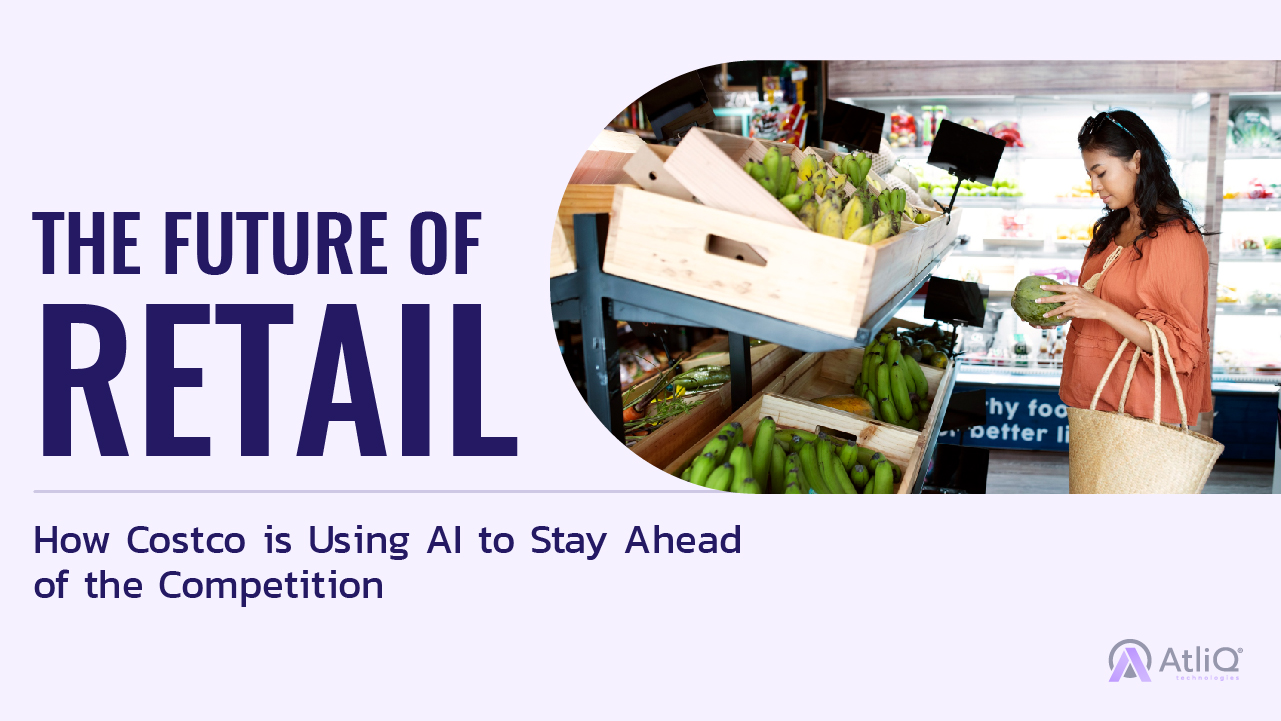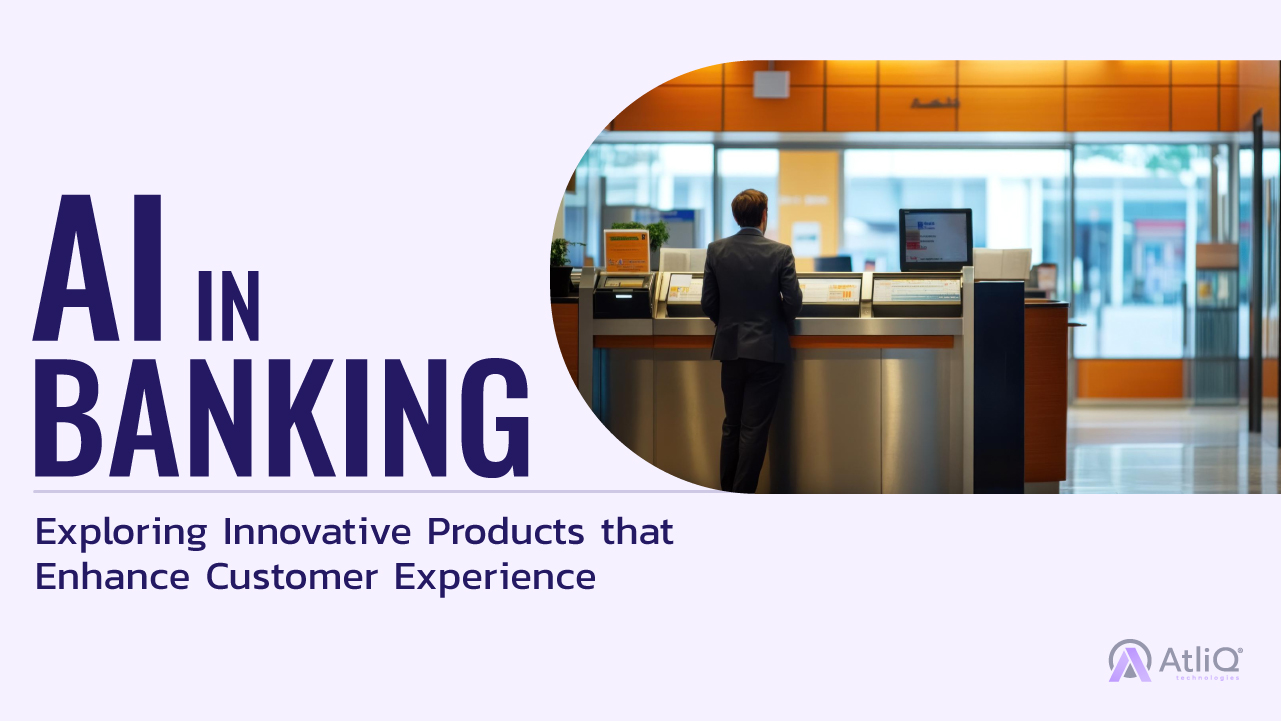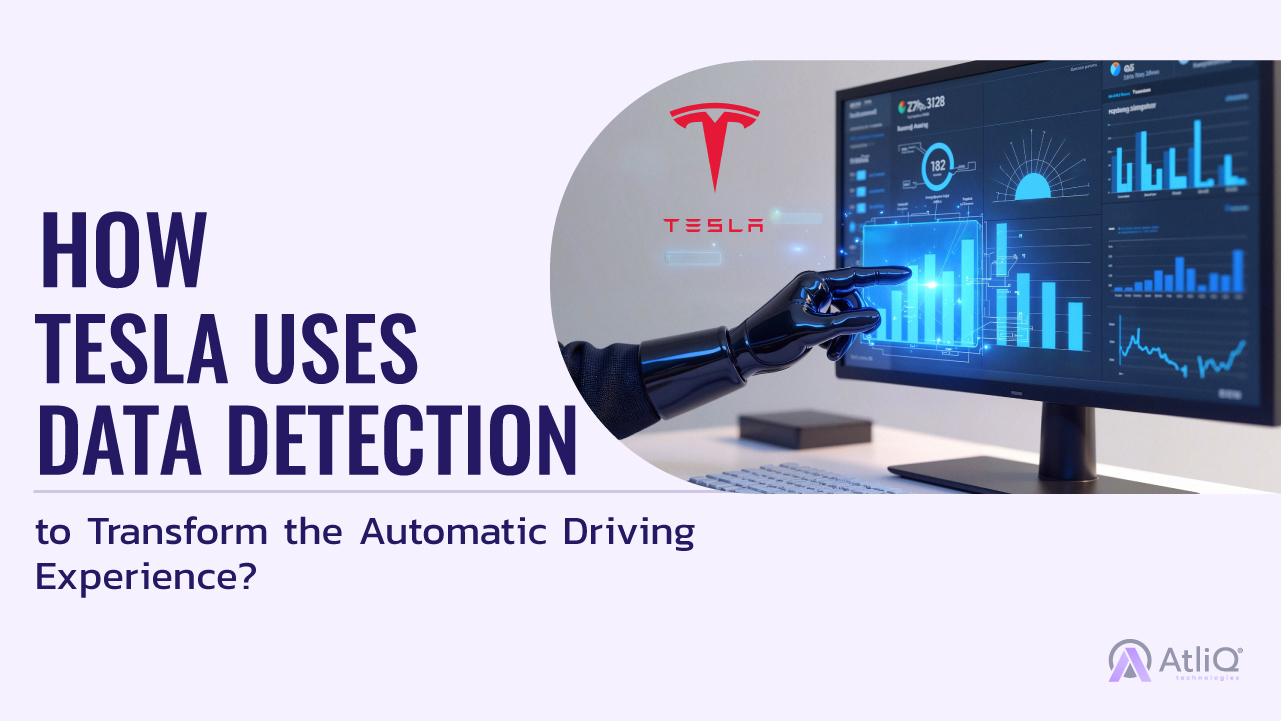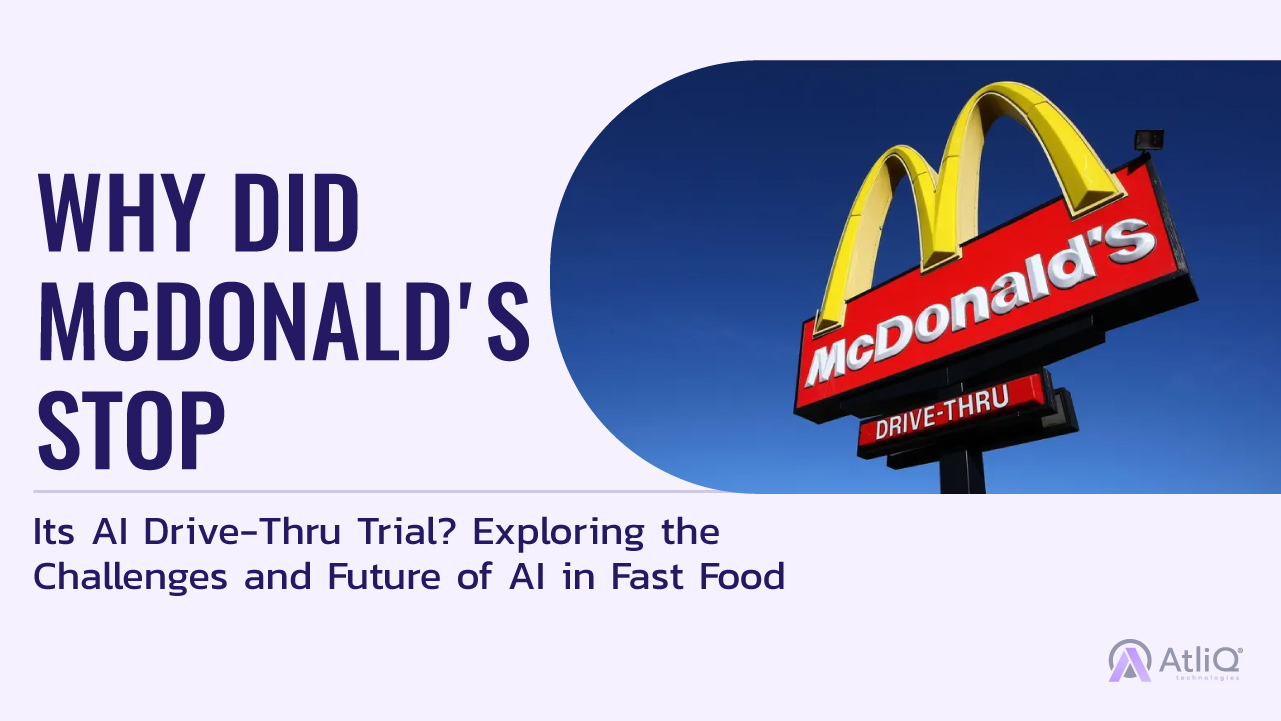
Picture this: you roll up to a McDonald’s drive-thru, ready to order your usual—a Big Mac, fries, maybe a shake. But instead of hearing the familiar “Welcome to McDonald’s,” you’re greeted by… an AI assistant! No humans, just a robot voice taking your order.
Well, McDonald’s did launched their AI drive-thru trial in 2021.
With 70% of McDonald’s sales coming through the drive-thru, the golden arches were betting on AI to serve us faster, smoother, and with fewer mix-ups. Who wouldn’t want their cheeseburger delivered at lightning speed? But as it turns out, the tech wasn’t quite ready to flip burgers like a pro. Imagine ordering a “medium Coke” and getting a “McChicken with extra mustard.” Yep, that happened.
Despite the promise of speeding up the 25 million daily orders McDonald’s processes globally, the AI struggled with accents, complex orders, and—let’s be honest—just keeping up with the chaos of hungry humans. So, what went wrong? Why did McDonald’s hit the brakes on their AI drive-thru experiment? Let’s dig into the hilarious and unexpected challenges that made McDonald’s realize, sometimes, even robots can’t handle a simple “no onions, extra pickles.”
The Promise of AI in Quick-Service Restaurants
The fast-food industry is built on one golden rule: speed. As customers, we want our food quick, hot, and correct, especially when we’re in the drive-thru. Enter AI technology—a potential game-changer for quick-service restaurants (QSRs) like McDonald’s, where speed, accuracy, and efficiency are non-negotiable.
AI in drive-thru operations promised to revolutionize how fast food is served. By automating the ordering process, AI could take the heat off employees and streamline customer experiences. In fact, AI-powered drive-thrus were projected to reduce service times by as much as 30%, allowing chains to process more orders during peak hours.
- Faster Service: AI could reduce average wait times by 30%, making the typical 349-second drive-thru experience much faster by processing orders more efficiently.
- Improved Accuracy: Order mistakes could be reduced by up to 50%, with AI handling orders more precisely than humans, minimizing errors like missed fries or wrong drinks.
- Reduced Labor Costs: By automating order-taking, AI could save the fast-food industry up to $12 billion annually in labor costs, freeing up employees for other tasks.
- Personalized Customer Interactions: AI could enhance customer loyalty by recognizing regulars and suggesting favorite meals, boosting customer satisfaction by up to 20% through tailored experiences.
While promising, McDonald’s AI drive-thru trial highlighted that technology still needs refining before it can fully deliver on these expectations.
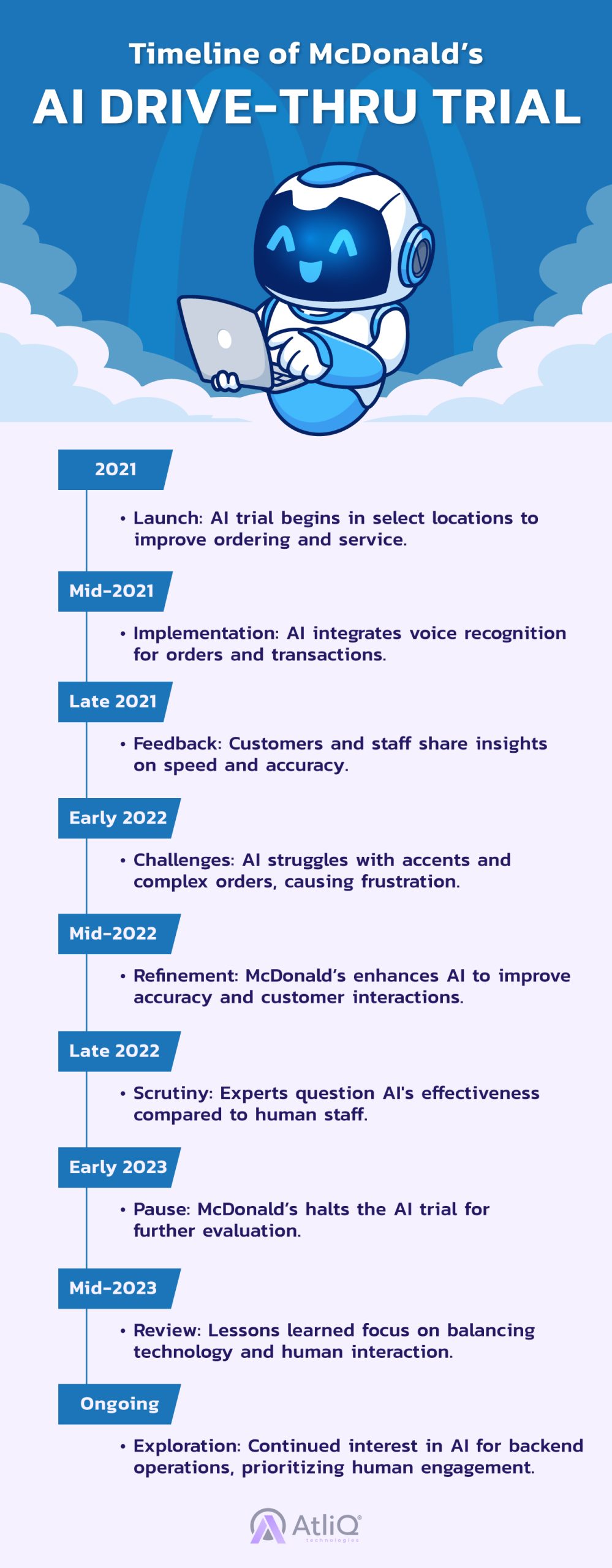
The Challenges McDonald’s Faced During the AI Drive-Thru Trial
While the AI drive-thru promised innovation, it hit several roadblocks that ultimately led McDonald’s to hit pause. Here’s a look at the key challenges:
- Accuracy Issues: The AI struggled with understanding various accents, dialects, and regional speech differences, leading to order mix-ups. This caused frustration for both customers and staff, as even basic orders were sometimes misinterpreted. For instance, a simple “medium Coke” could be mistaken for a “McChicken” if the AI failed to recognize certain pronunciations.
- Customer Frustration: Miscommunications caused by the AI led to negative customer experiences. When orders were misunderstood or incorrect, customers were often left feeling irritated, as the back-and-forth clarification process took longer than usual, defeating the very purpose of AI speed.
- Complex Menu Orders: While AI handled simple orders reasonably well, customizations like “no onions, extra pickles” posed a significant challenge. AI systems had difficulty managing the complexity of these requests, often leading to errors, which compounded customer dissatisfaction.
- Operational Integration: Integrating AI seamlessly with human staff operations proved harder than expected. Employees still needed to step in to fix errors, slowing down the process and adding extra work rather than alleviating it. The lack of a smooth handoff between AI and staff created operational inefficiencies, reducing the overall benefit of the system.
These challenges revealed that while AI offers exciting potential, it still needs substantial fine-tuning before it can replace human interaction at McDonald’s drive-thrus.
Employee and Human Element in Customer Service
While AI promises speed and efficiency, it lacks the warmth and adaptability of human interaction, which remains a crucial part of the drive-thru experience. For many customers, a friendly “Hi, welcome to McDonald’s!” from an employee sets the tone, and that personal connection can’t be replicated by a robotic voice.
Human employees bring flexibility to problem-solving, something AI struggled to handle during the trial. Whether it’s dealing with custom orders, handling customer complaints, or managing unique situations like a missing item or dietary request, humans can quickly adapt and find solutions on the spot. AI, however, can get stuck—unable to process complex requests or fix issues on the fly, often leaving customers frustrated.
This lack of adaptability may have been one of the reasons McDonald’s hit pause on their AI drive-thru trial. No matter how advanced the technology, it can’t yet match the creativity, empathy, and flexibility that human staff bring to fast-food service.
Cost vs. Benefit: Was It Worth It?
When it comes to implementing AI in drive-thrus, the big question is: was it worth the investment? As McDonald’s explored the potential of AI, they had to weigh the financial implications of maintaining and scaling this technology against traditional labor costs.
Financial Implications of AI Systems: Implementing an AI system isn’t cheap. Initial setup costs can skyrocket into the millions, covering software development, hardware installation, and ongoing maintenance. A 2020 study showed that 74% of organizations reported higher operational costs after deploying AI technologies due to these factors. While the goal is to save money in the long run, the upfront investment can be daunting.
Comparing Costs: AI vs. Human Labor: On the flip side, labor costs for fast-food employees also add up. The average hourly wage for fast-food workers in the U.S. is around $13.50, which can equate to significant annual expenses for chains like McDonald’s. With around 1.7 million employees in the U.S. alone, labor costs can exceed $23 billion annually.
AI systems can greatly reduce labor costs once established. Estimates suggest QSRs could save up to $12 billion annually by streamlining operations and lowering staffing needs during peak hours. However, these savings depend on successful implementation.
The decision involves balancing AI’s immediate costs with long-term benefits. While AI can enhance service and cut costs, McDonald’s faced challenges that raised doubts about feasibility.
Ultimately, the promise of faster service and reduced labor costs must be weighed against the importance of human connection and operational hurdles. McDonald’s reflects on its AI journey, highlighting that while innovation is crucial, the value of human interaction is irreplaceable.
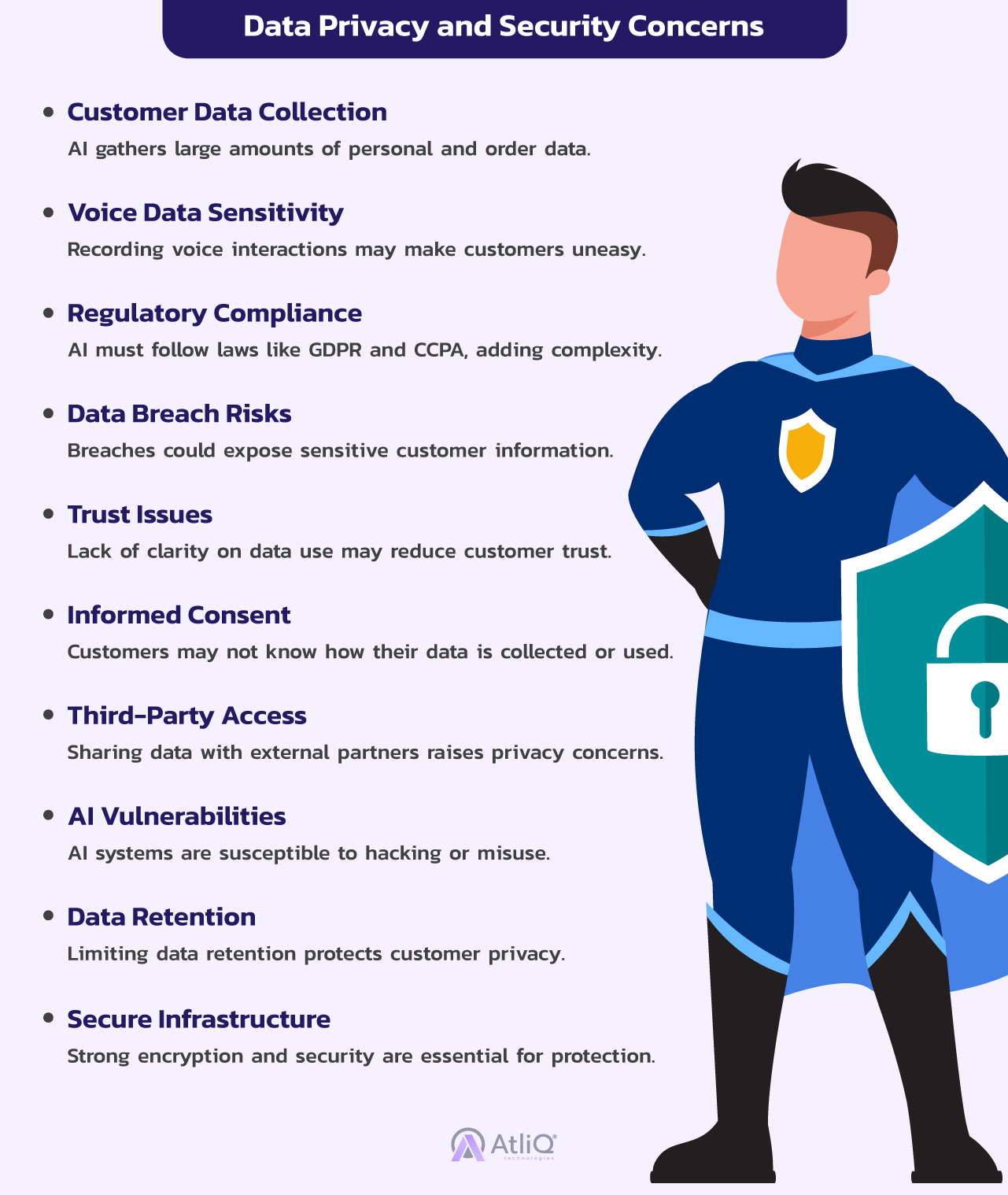
The Decision to Pull the Plug
In the fast-paced world of fast food, McDonald’s decision to discontinue its AI drive-thru trial raised eyebrows and sparked discussions about the future of technology in customer service. Here’s a timeline of events and insights into their choice.
While McDonald’s did not release extensive public statements regarding the discontinuation, a spokesperson noted, “We continuously strive to enhance customer experiences, and while AI has great potential, we recognize the importance of human interaction and the challenges we’ve faced.” This acknowledgment highlighted the company’s commitment to balancing innovation with customer satisfaction.
Is This A Complete Discontinuation or Just A Pause?
The decision to pause the AI trial is not necessarily a complete discontinuation. McDonald’s has expressed interest in refining the technology and exploring its potential for future applications. This suggests that while the current iteration of the AI drive-thru may be on hold, the company is not entirely abandoning the idea of integrating AI into their operations.
McDonald’s decision to pull the plug on the AI drive-thru trial reflects a thoughtful approach to innovation. By taking the time to assess the technology’s challenges and implications, they are paving the way for potential improvements in the future. For now, it seems the golden arches are putting a temporary hold on the AI experiment, with an eye toward smarter, more effective solutions down the road.
Lessons Learned: What the Fast-Food Industry Can Take Away
McDonald’s AI drive-thru trial offers valuable lessons for the fast-food industry. Here are key insights for other quick-service restaurants (QSRs):
- Prioritize Human Interaction: Human connection in service is vital. Balance AI efficiency with personal interaction.
- Test and Learn Approach: Use phased pilot programs to identify challenges. Gather continuous feedback from customers and staff.
- Focus on Accuracy and Flexibility: AI should handle diverse customer needs, including accents and complex orders. Invest in technology that improves understanding.
- Transparency with Customers: Communicate clearly about data collection and usage. Build trust regarding security and privacy.
Where AI Still Holds Potential?
Despite challenges in the drive-thru, AI offers significant opportunities in other areas:
- Backend Operations: Optimize supply chain management and inventory tracking for better efficiency.
- Delivery Systems: Enhance delivery logistics with AI for timely, accurate deliveries.
- Customer Insights: Analyze data to identify trends, tailoring marketing and menu offerings.
- Chatbots for Customer Service: Use AI chatbots for common inquiries, allowing staff to handle complex interactions.
The Future of AI in Fast Food
McDonald’s decision to discontinue its AI drive-thru trial sends ripples through the fast-food industry, prompting a reassessment of AI adoption. Here’s what this means for the future of AI in fast food:
Impact of Discontinuation on AI Adoption
- Caution in Implementation: McDonald’s experience highlights the need for caution when adopting AI. Other QSRs may take a step back to evaluate their own strategies and technologies.
- Focus on Human-Centric Solutions: The emphasis on human interaction may lead to more hybrid models that integrate AI while preserving personal service.
- Enhanced Training for AI: Companies may invest more in training AI systems to better understand diverse customer needs, aiming to reduce errors and enhance customer satisfaction.
Predictions for Future Innovations
- Backend Automation: Expect significant growth in AI for backend operations. This includes inventory management, predictive analytics, and supply chain optimization.
- Personalized Marketing: AI will likely enable more personalized marketing campaigns. Analyzing customer preferences can help tailor promotions and menu offerings.
- Robotics in Food Preparation: Innovations in robotics may emerge, with AI-driven machines assisting in food preparation to increase efficiency and consistency.
- Enhanced Customer Interactions: Future AI systems may focus on creating more engaging and human-like interactions, using advanced natural language processing.
Challenges Ahead
- Data Privacy Regulations: As AI usage expands, so will concerns about data privacy. Compliance with regulations will be crucial.
- Public Perception: There may be ongoing skepticism about AI’s role in customer service. Fast-food chains must address concerns and educate customers.
- Integration with Existing Systems: Successfully integrating AI with current operations and training staff to work alongside technology will remain a challenge.
The future of AI in fast food is a balancing act. While McDonald’s discontinuation of its AI drive-thru trial serves as a cautionary tale, it also opens the door to exploring new possibilities. By focusing on enhancing human elements and addressing challenges, the industry can harness AI’s potential to improve operations and customer experiences.
The journey of McDonald’s AI drive-thru trial reveals the complexities of integrating technology into the fast-food industry. While the promise of AI lies in enhancing efficiency and customer experiences, the challenges encountered serve as important lessons for other quick-service restaurants.
As the industry moves forward, it’s clear that a balance between innovation and human interaction is essential. The discontinuation of the trial does not signify the end of AI in fast food but rather an opportunity for reflection and refinement. Future innovations in backend operations, personalized marketing, and customer engagement hold great potential, yet they must be approached with caution and transparency.
Ultimately, the fast-food sector stands at a crossroads, where embracing technology and valuing the human touch can lead to a brighter, more efficient future. By learning from past experiences and remaining adaptable, the industry can pave the way for successful AI integration that enhances both operations and customer satisfaction.
